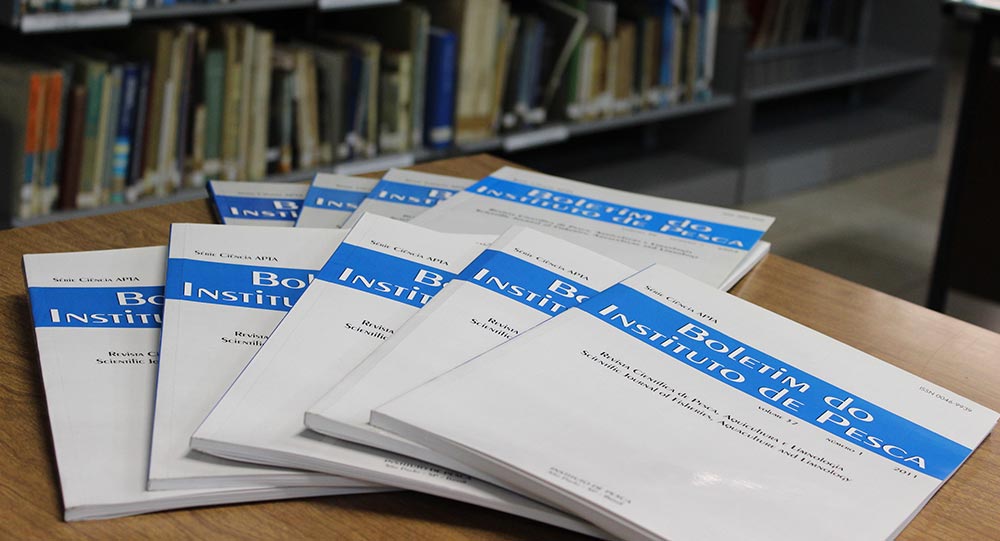Histology of the gonads of the hybrid Pseudoplatystoma punctifer X Leiarius marmoratu
Keywords:
pisciculture, germinative cells, spermatocytes, ovaryAbstract
Considering the rapid expansion of fish farming in intensive systems and the use of hybrids in Brazil, the study regarding the breeding capacity of the most recent hybrid is of ecological importance. If these animals are fertile, they may breed with the parental species in the wild and can negatively affect the genetic variability of the population (parental species in the wild). Fragments of the gonads were collected and submitted to histological evaluation. Histological cuts were stained with eosin/hematoxylin and toluidine, and slides were randomly selected for observation of three fields of each animal, through light microscopy. Gonads of all fishes were paired structures of elongated shape in the abdominal cavity, covered by an albuginea tunic. Male juveniles presented primary spermatocytes while juvenile females presented chromatin nucleolus oocytes. Adult females presented chromatin-nucleolus oocytes, perinuclear, cortical alveoli, and vitelogenic oocytes visible in various sizes. The presence of oocytes in different stages and primary spermatocytes indicate that these fish may be fertile. Fish hybridization represents a threat to the conservation of native species.
References
thynnus. Journal of Morphology, 264(2): 149-160.
ANDRADE, V.X.L. 2007 Desempenho reprodutivo do pintado, Pseudoplatystoma corruscans (Spix &Agassiz, 1829), criado em sistema intensivo com dietas contendo diferentes níveis proteicos e
suplementada com óleo de milho. Jaboticabal. 98p.(Tese de Doutorado Universidade Estadual
Paulista. Centro de Aquicultura da UNESP).Disponível em: <http://www.caunesp.unesp.br
/publicacoes/dissertacoes_teses/teses/> Acesso em: 10 jun.2015.
BARTLEY, D.M.; RANA, K.; IMMINK, A.J. 2001 The use of interspecific hybrids in aquaculture and
fisheries. Reviews in Fish Biology and Fisheries, 10(3): 325í 337.
BOTERO, M.; FRESNEDA, A.; MONTOYA, A.; OLIVERA-ÁNGEL, M. 2004 Descripción del Desarrollo embrionario de zigotos híbridos obtenidos por el cruce de machos de Cachama Blanca (Piaractus brachypomus) y hembras de Cachama Negra (Colossoma macropomum).Revista Colombiana de Ciencias Pecuarias, 17(supl.):38-45.
BRITO, M.F.G. and BAZZOL, N. 2003 Reproduction of the surubim catfish (Pisces, Pimelodidae) in
the São Francisco River, Pirapora Region, Minas Gerais. Arquivo Brasileiro Medicina Veterinária e
Zootecnia, 55(5): 624-633.
CHAVES, G.V. 2011 Técnica de videoceloscopia para sexagem em surubim (Pseudoplatystoma
corruscans x Pseudoplatystoma reticulatum). Belo Horizonte. 61p. (Dissertação de Mestrado)
Universidade Federal de Minas Gerais). Disponível em: <http://www.bibliotecadigital.ufmg.br/dspace> Acesso em: 10 jun. 2015.
CREPALDI, D.V.; TEIXEIRA, E.A.T.; FARIA, P.M.C.;RIBEIRO, L.P.; SATURNINO, H.M.; MELO, D.C.; SOUSA, A.B.D.; CARVALHO, D.C. 2006a A ultra-sonografia na piscicultura. Revista Brasileira de Reprodução Animal, 39(3): 174-181.
CREPALDI, D.V.; FARIA, P.M.C.; TEIXEIRA, E.A.T.; RIBEIRO, L.P.; COSTA, A.A.P.; MELO, D.C.;
CINTRA, A.P.R.; PRADO, S.A.; COSTA, F.A.A.; DRUMOND, M.L.; LOPES, V.E..; MORAIS, V.E.
2006b Biologia reprodutiva de Surubim (Pseudoplatystoma corruscans). Revista Brasileira de
Reprodução Animal, 30(3): 159-167.
FAUSTINO, F.; NAKAGHI, L.S.O.; MARQUES, C.; MAKINO, L.C.; SENHORINI, J.A. 2007 Fertilização e desenvolvimento embrionário: morfometria e análise estereomicroscópica dos ovos dos híbridos de surubins (pintado,Pseudoplatystoma corruscans x cachara, Pseudoplatystoma fasciatum). Acta Scientiarum.Biological Sciences, 29(1): 49-55.
HASHIMOTO, D.T.; PARISE-MALTEMPI, P.P.; LAUDICINA, A.; BORTOLOZZI, J.; SENHORINI, J.A.; PORTO-FORESTI, F. 2009 Repetitive DNA probe linked to sex chromosomes in hybrids between Neotropical fish Leporinus macrocephalus and Leporinus elongatus (Characiformes, Anostomidae). Cytogenetic and Genome Research,124(2): 151í 157.
HASHIMOTO, D.T; MENDONí"¡A, A.F.F.;SENHORINI, J.A.; BORTOLOZZI, J.; OLIVEIRA, C.; PORTO-FORESTI, F. 2010 Identification of hybrids between Neotropical fish Leporinus macrocephalus and Leporinus elongatus by PCRRFLP and multiplex-PCR: tools for genetic monitoring in aquaculture. Aquaculture, 298(3-4):346í 349.
HASHIMOTO, D.T.; MENDONí"¡A, F.F.;SENHORINI, J.A.; OLIVEIRA, C.; FORESTI, F.; PORTO-FORESTI, F. 2011 Molecular diagnostic methods for identifying Serrasalmid fish (Pacu, Pirapitinga, and Tambaqui) and their hybrids in the Brazilian aquaculture industry. Aquaculture, 321(1-2): 49í 53.
HASHIMOTO, D.T.; SENHORINI, J.A.; FORESTI, F.;PORTO-FORESTI, F. 2012 Interspecific fish
hybrids in Brazil: management of genetic resources for sustainable use. Reviews in Aquaculture, 4(2): 108-118.
LUCA, A.S. 2010 Aspectos da reprodução e da alimentação de Pseudoplatystoma punctifer
(Castelnau, 1855) (Siluriformes, Pimelodidae) na bacia do rio Teles Pires, Alta Floresta í MT. São
Carlos. 108p. (Tese de Doutorado. Universidade Federal de São Carlos). Disponível em:<http://www.bdtd.ufscar.br/htdocs/tedeSimplificado//tde_busca> Acesso em: 10 jun.2015.
MUHLFELD, C.C.; KALINOWSKI, S.T.; MCMAHON,T.E.; TAPER, M.L; PAINTER, S.; LEARY, R.F.;
ALLENDOR, F.W. 2009 Hybridization rapidly reduces fitness of a native trout in the wild.
Biology Letters, 5(3): 328-331.
PORTO-FORESTI, F.; HASHIMOTO, D.T.; ALVES,A.L.; ALMEIDA, R.B.C.; SENHORINI, J.A.; FORESTI, F. 2008 Cytogenetic markers as diagnoses in the identification of the hybrid between Piauçu (Leporinus macrocephalus) and Piapara (Leporinus elongatus). Genetics and Molecular Biology, 31(1): 195-202.
PORTO-FORESTI, F.; HASHIMOTO, D.T.; SENHORINI, J.A., FORESTI, F. 2010 Hibridação em piscicultura: monitoramento e perspectivas.In: BALDISSEROTTO, B. and GOMES, L.C. (eds)
Espécies nativas para a piscicultura no Brasil.Universidade Federal de Santa Maria, Santa
Maria. p.589í 606.
RESENDE, E.K.; CATELLA, A.C.; NASCIMENTO,F.L.; PALMEIRAS, S.S.; PEREIRA, R.A.C.; LIMA, M.S.; ALMEIDA, V.L.L. 1995 Biologia do curimbatá (Prochilodus lineatus), pintado (Pseudoplatystoma corruscans) e cachara (Pseudoplatystoma fasciatum) na bacia hidrográfica do rio Miranda, Pantanal do Mato Grosso do Sul. Boletim de Pesquisa, Corumbá,MS: EMBRAPA í CPAP, n. 02. 75p.
ROMAGOSA, E.; PAIVA, P.; TALMELLI, E.F.A.; GODINHO,H.M. 2003a Biologia reprodutiva de
fêmeas de cachara, Pseudoplatystoma fasciatum(Teleostei, Siluriformes, Pimelodidae), mantidas
em cativeiro. Boletim do Instituto de Pesca, 29(2):151-159.
ROMAGOSA, E.; PAIVA, P.; GODINHO, H.M.;TALMELLI, E.F.A. 2003b Características morfométricas e crescimento do cachara, Pseudoplatystoma fasciatum (Linnaeus, 1766), em cativeiro. Acta Scientiarum Animal Sciences, 25(2):277-283










